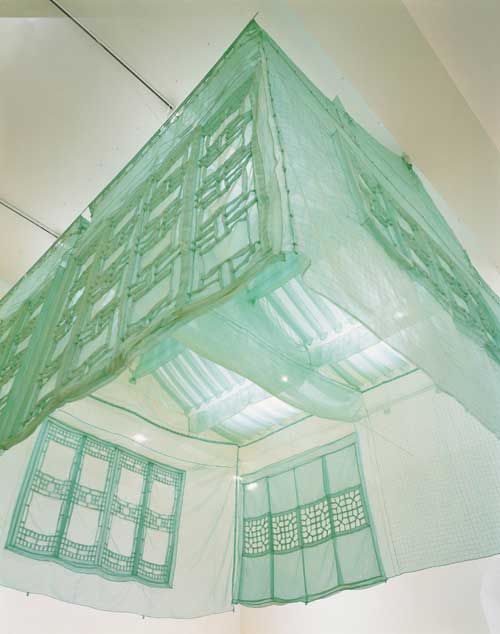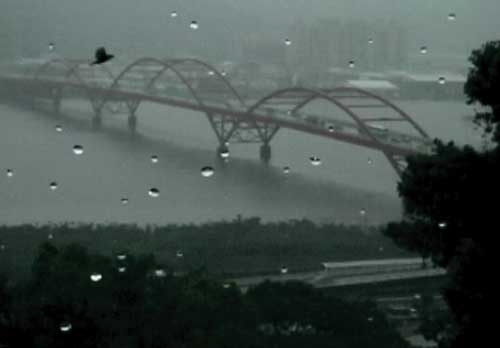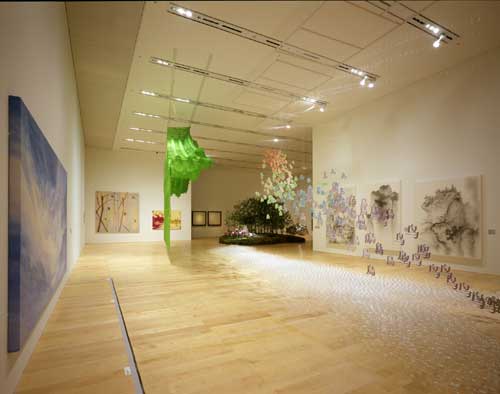

Mori Art Museum, Tokyo
29 March - 19 June 2005
One of the exhibition's intentions is to 'counteract Western prejudice'2 or the West's tendency to judge the art of other cultures according to its own formal framework of criticism. Perhaps though, this framework is impossible to escape entirely, even the identity of difference implied by the subtitle 'from East Asia' could be seen as playing the game according to Western rules. Furthermore, the artists exhibited here all practise in a cultural context in which Western ideas and objects are so commonly encountered, that a wholesale denial of them is somewhat futile. However, as Sunhee suggests in the exhibition catalogue, the emergence since the 1980s of an internationalist set of artists working in new media and technology supports the view that tradition never dies, it just evolves. A sense of historical continuity and of an aesthetic perspective that diverges significantly from that of many Western artists is discernable and this show has been designed to allow it maximum resonance.
The exhibition has been split into two parts in a way that reflects the traditional divisions of East Asian art. The first, 'San sui', groups together works that deal with the outer landscape; the second, 'Feng shui', focuses on the inner landscape, or what might be loosely termed interior design. As the name suggests, it has been laid out using feng shui as a guiding principle.
The exhibition opens with Kobayashi Toshiya's series of landscape photographs entitled 'Landscape in the Mist'. These ambiguous shots of a German forest were taken from a speeding car with a high-speed camera, but the resulting work is reminiscent of 'sumi-e', Japanese ink and brush paintings. The merest suggestion of trees is enough to set the imagination free in a landscape of delicate greys, in confirmation of the Buddhist-inspired precept that the partial can stand for the whole.
A similar philosophy can be detected in the oil paintings of Song Hyun-Sook, in which sparse techniques create ambiguity. In '9 Brushstrokes, Dec. 1, 2003', for example, what appears to be a swathe of delicate fabric hung from a bamboo bar is constructed from the eponymous nine strokes. The flowing lines recall calligraphy and traditional ink painting, but the deliberate foregrounding of technique in the title blurs the boundary between representation and abstraction. Are we supposed to view these works in the light of abstract expressionism, or to see in their silence and use of space the unbroken line of a much older tradition?
Other pieces are concerned with the reanalysis of traditional landscape masterpieces in the light of contemporary East Asian culture. Whang Inkie's 'Mt. Tiger after Rain' is a rendering, in the sharply contrasting medium of reflective crystal pieces over a black painted board, of the scanned image of a classical Korean landscape painting. A hint of the serenity of the original remains, despite the artificial iridescence of the materials.
In contrast, Yoo Seung-Ho's work 'shoooo...' retains, from a distance, its ancient appearance: a monochrome landscape of mountains and waterfall. It is only on closer inspection that this piece, a reproduction of a painting by the Chinese old master Guo Xi, reveals itself as composed of hundreds of tiny repetitions of the word 'shoooo' written in pen in modern Korean script. Seung-Ho found the word in a Japanese comic book as the onomatopoeic description of a rocket's lift-off. Two other pieces use the words 'yodeleheehoo' and 'dada' to construct similarly vertiginous rock-and-water landscapes. This practice of dislocating words as carriers of meaning could perhaps be read as a reference to the Buddhist tradition of paradoxical riddles, designed to create a rational impasse and allow access to deeper levels of understanding.
Kwon Ki-Soo's video art is even more tongue-in-cheek. In his animated film, 'Plum Blossoms around a Cottage - Visiting a friend on a snowy day', Kwon inserts his cartoon alter ego, Donguri, into a classical landscape setting by the Korean painter Goram Jonki (1825-1854).
The first part of the exhibition has been organised as if it were itself a landscape painting, allowing visitors to experience the juxtaposition of different pieces. Thus, Suh Do-Ho's 'North Wall', a stitched recreation in translucent green fabric of the north façade of the artist's Seoul house, is suspended over Shon Jeung-Eun's 'The River of Immortality', a meandering collection of plastic glasses filled with antiseptic solution. The river ends in a small pond where Xu Bing's 'The Living Word' takes off. This installation begins in a text laid out on the floor, featuring the Chinese character meaning 'bird'. From this 'bird', many more characters lift off in a flock towards the ceiling, gradually changing shape into pictograms and finally into realistic bird forms.
The second part of the exhibition has been planned according to the traditional geomantic principles of feng shui, in an effort to escape the 'white cube' method of presentation and provide an environment in harmony with the works. The feng shui expert, Hong Sung-Dong, was enlisted to plot the presence of exterior natural forces such as Tokyo Bay and Mount Fuji and to divide the space, like a home, into areas suitable for recreation, meditation, eating, or relaxing, according to the nature of the artworks.
Akira Yamaguchi is primarily known for his detailed paintings in the classical Japanese manner which collapse asynchronous subjects together in a way that is equally informed by art history and sci-fi manga. His 'Portable Folding Tea Ceremony Room' updates the austere aesthetic of the tea room, constructing a tiny hut from corrugated plastic with a camping stove inside. The overall effect is somewhat like an earthquake relief centre, and really quite funny, the absurdity lying in the juxtaposition of studied ritual with modern materials and take-away philosophy. The other installation shown here, 'White Path', is a fairly literal rendering of a Buddhist allegory with a modern twist.
In the exhibition catalogue, the Mori's Deputy Director, Nanjo Fumio, claims:
In one view, the West sees nature as something that human beings are in conflict with and that human beings must control and rule over, whereas the East sees nature as something that is accepted and loved, something that is more human.3
Whether one accepts this opinion or not, a few works in this exhibition do make political points, such as 'Eating Landscape' by Song Dong, a Beijing-based artist who has previously exhibited at the Tablet Gallery in London. In his video projections, miniature landscapes sculpted from food are disrupted by the appearance of a hand and a pair of chopsticks that consume the beauty, bit by bit. The calligraphy adorning the landscapes is revealed as a mundane list of ingredients and recipes - though only if you can read Chinese characters. The work is a sarcastic, thought-provoking joke on those who can see the beauty of the calligraphy or landscape but cannot understand its deeper import.
Lee Mingwei's 'The Dining Project' also plays with ideas of food and politics, but in an attempt to forge links between people. When the exhibition opened, Mingwei selected a member of the visiting public by random lottery, and invited that person to share a meal he cooked. The remains of that moment of civilised interaction remain in the empty dishes carefully replaced on a low table.
While it is perhaps unwise to push too hard the notion of a uniquely East Asian aesthetic - doing so flattens out the personal and cultural individuality of the more international artists featured in this exhibition - it is fascinating to see the various ways in which the multiple but related traditions of this part of the world are being grappled with and addressed. Notions of landscape and people's place in that landscape, the dialogues between tradition and modernity, the virtues of ambiguity and the half-hidden thing are all highlighted by the sensitive curatorship of Kim Sunhee and her team.
Above all, 'The Elegance of Silence' is an opportunity to view work by an exciting range of contemporary artists for whom the clash of cultures means fertile new fields of work.
James Wilkes
References
1. Sunhee K. Hisurebahana, or the Hidden and the Revealed Flower. In: Sunhee K (ed.) The Elegance of Silence: Contemporary Art from East Asia. Tokyo: Mori Art Museum, 2005: 16.
2. Ibid: 16.
3. Fumio N. The Flowers of Asia. In: Sunhee K (ed.) The Elegance of Silence: Contemporary Art from East Asia. Tokyo: Mori Art Museum, 2005: 27.




